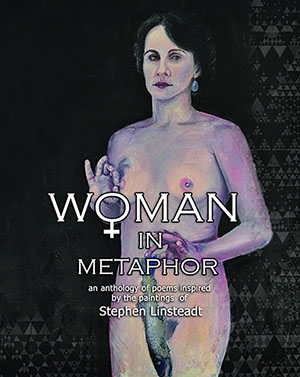 |
Comment on this
article

Woman in Metaphor
by Maria Elena B. Mahler, ed.
27 poems/ 82pp/
Natural Healing House Press
www.NaturalHealingHousePress.com
Reviewed by Ed Bennett
Anthologies are usually straightforward: there is a unifying theme and a body of poetry or essays that address the theme.
Maria Elena B. Mahler's anthology, Woman in Metaphor approaches the theme of womanhood from different angles: the art of
Stephen Linsteadt and a collection of poems from 27 poets, both male and female. The anthology as a whole creates a skewed
view of what is typically “womanly” by combining these fine paintings with poetry that begs to be read aloud. Unlike other
anthologies, Woman in Metaphor does not put its subject beneath a bright light for examination. Rather it presents a diffrac-
ted view where the subject is spread out in all of its component parts like white light being broken into a brilliant chromatic
spectrum.
Stephen Linsteadt’s artwork covers a broad range of the female form. His subjects are seen in bright light and in shadow,
in childhood, adulthood and old age. One of the more intriguing works is “Sophia and Eight Malic Forms”, an oil on canvas
figurative work with the lightness of a Chagall. What the paintings themselves seem to present is not just a figure study
of the female form. There is an intellectual depth to each of the works where one is given the ability to see beyond shape
into the spiritual makeup of each subject. The paintings themselves are worth the price of the anthology.
The poetry found interspersed between the paintings, again, is somewhat different than expected. Despite the juxtaposition
of artwork and poetry, there are few poems that would fit the description of ekphrastic poetry. The artwork in most instances
provides a launching point for the poet. Yet, while the poems diverge from the subject of the art, they also issue a deeper
meaning to the womanly metaphor by delving into the holistic idea of femininity, not just the external.
Genie Nakano’s poem, “Kokoro” is an example of how both word and picture create both a complex and an ethereal variation on
the theme. She writes:
“Bathing in warm water
I fall asleep
and dream of mother
she is wearing pink
scent of roses floats in water.”
The poem is about memory, specifically a young girl’s memory about her mother. The title means much more when translated
from the Japanese. Literally, it means “heart” but it has shades of meaning ranging from “the heart of things” to “feelings”.
Each of the facets of the author’s “kokoro” can be found within the poem.
Nancy Scott Campbell’s poem “Luminous Hours” turns the table on the artist/model relationship with her declaration:
“You the Artist
and I, Anima,
from this we arise”
This is not a passive model allowing the artist to act on her. This is a woman who takes the act of creation into her own hands
and allows the creation to live on her own terms.
Sharmagne Leland-St. John’s “Hearth Beat” presents a facet of womanhood unencumbered. Arising from the brief memory of a lover’s
hearth she walks forward, alone and with anticipation.
“My heart beats
to a new rhythm
the pulse of infinite wisdom.”
And here we have come full circle, from a painting of Sophia the Wise to the words of an empowered woman in her quest for infinite
wisdom.
As mentioned, the artwork alone is worth the price of the anthology and the same can be said for the poetry. However, if you are
expecting the usual classical female figure studies or poetry that sings the songs of love, requited or otherwise, this is not for
you. Woman in Metaphor is not just about gender, it is an analysis of the meaning gender and all of the spiritual dimensions that
it comprises. The poetry and art combine to give us what any great work of art strives for – a new way of envisioning a topic.
Return to:
|


